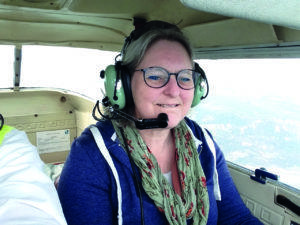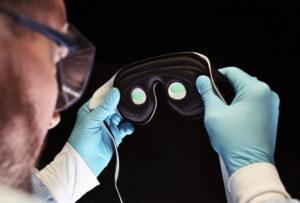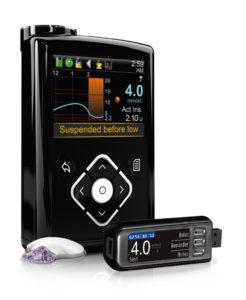
UP IN THE AIR: Sue Wales enjoying a flying lesson for her 50th birthday wearing a Medtronic insulin pump and a FreeStyle Libre.
Sue Wales was 18 when she was diagnosed with Type I diabetes in 1983 just when she was due to start training to be a nurse. She recalls, “I had to have a medical prior to starting the course. It was during that when they picked up that I had a high blood glucose level. I had just done my A levels, and I put the tiredness I had been feeling down to that. I was drinking water like a fish and I was quite skinny, in fact I’d never been as skinny as that before or since. Looking back I recall that doing my exams was hard, as I needed the loo all the time, but I even put that down to nerves.”
Back to her diagnosis, Wales says, “At university, after my medical checkup in the morning, the hospital staff called me straight back to the hospital. They had called my parents in and told us that I had such high blood glucose and ketone levels that I should have collapsed already and it meant that I had Type 1 diabetes. We were all taken by surprise as diabetes was not in the family, although there was one relative who I was told died of a ‘wasting disease’ in the early 1900s, and now I wonder if it was diabetes.
 This was back in the 80s, and Wales’ diagnosis was pretty stark, “I was told at the time that I wouldn’t make it to 50 years old, and was likely to face some serious health problems. That’s basically what you were told back then. I was told I needed to start doing injections and given the equipment to give myself Mixtard insulin twice a day and told what food I should eat to match the insulin dose. There were no blood test meters back then; I had tablets that I dropped into my urine in a test tube that changed colour; blue meant you had a safe reading of glucose in your urine, orange meant your sugars were high. That was all we had back then. We know now that this was a very inaccurate reading, as your urine would have accumulated over a couple of hours so it would be a mix of several hours of eating, and so on.”
This was back in the 80s, and Wales’ diagnosis was pretty stark, “I was told at the time that I wouldn’t make it to 50 years old, and was likely to face some serious health problems. That’s basically what you were told back then. I was told I needed to start doing injections and given the equipment to give myself Mixtard insulin twice a day and told what food I should eat to match the insulin dose. There were no blood test meters back then; I had tablets that I dropped into my urine in a test tube that changed colour; blue meant you had a safe reading of glucose in your urine, orange meant your sugars were high. That was all we had back then. We know now that this was a very inaccurate reading, as your urine would have accumulated over a couple of hours so it would be a mix of several hours of eating, and so on.”
Wales continued at university playing lots of sport and doing the kinds of things that students do, which was not a disciplined life, but carried on training to become a qualified nurse, then ended up working as a sister on a diabetes ward in a hospital the early ‘90s. “That was hard,” she remembers, “I was seeing the effect diabetes was having on people, but I just got on with it. I was lucky that the staff would keep an eye out for me and would tell me if I went a bit ‘wibbly’, which was my word for having a low blood sugar. In the main I had not had many bad hypos as my fingers and lips would tingle when a low was coming on so I mostly knew when it was happening.”
Clinical inertia
Attending the annual diabetes check up, Wales says, “It always felt like an annual ‘telling off’ when I went to the clinic. Of course I thought I knew all I needed to because of my job at the hospital. By the early ‘90s I was on an insulin pen of Actrapid plus a long-acting Ultratard daily injection. I soon stopped attending regular checkups as I didn’t really see the point, but by now there were Urine test sticks so I was using them for myself. Then we started using a blood glucose meter on the ward so I went and purchased myself one from the high street chemist, with my GP prescribing the test strips. Once I was using an insulin pen and was blood testing I began to get more involved in my diabetes care.”
Continuing with her career, blood testing and using an insulin pen, Wales attended annual eye tests as part of her diabetes care. It wasn’t until 2012 that Wales was urgently referred to the eye hospital as she had her first retinal bleed.
She says, “I was referred to have treatment for diabetic retinopathy five years ago. It is a shock when you get sent on to further treatment. At that point in time my eyesight was not affected much but signs of damage were identified that meant I needed laser treatment. I experienced what they call ‘floaters’, where you can see a sort of spider-y effect in your vision from weak vessels in my retina at the back of my eye bleed. I ended up having repeated bleeds so received almost monthly laser treatments to seal off the bleeds, but causing scarring to the back of my eye. The laser treatment did enable me to keep driving for longer. When you have laser treatment you have to inform the DVLA. I need to drive in order to get to my job and to maintain my active, independent life. I had previously been having three-yearly DVLA checks and soon had them annually due to the amount of laser I was receiving. I was terrified of losing my sight. What if I could not drive? If I lost my job I could not earn, how would I live?”
Wales worked in a part of the NHS’s innovations body in an Academic Health Service Network (AHSN). AHSNs encourages innovation and helps providers to hook up with appropriate patient groups and health care professionals, and that was when she came across the Noctura eyemask device and this turned out to be the first technology that she had ever used other than a blood test meter. At that point she was not yet on an insulin pump and had not used any form of glucose monitoring sensor.
“I’d had a lot of laser treatment at this point,” she says, “and obviously I did not want my eyes to get worse, so I looked into this sleep mask in greater detail and decided that I needed to try it out. Five years later, the Noctura eyemask has quantifiably proven to have improved my eye health. I had been having bleeds in my eyes, roughly one a month, and I’ve only had one since starting to use the eyemask four years ago.” My NHS eye clinic now only reviews me every three months and I’m back on to three-yearly DVLA review.
Pump action
It was about this time that insulin pumps were starting to be made available. “Once I was using the Noctura eyemask,” says Wales, “I tried to get even better control of my diabetes as another weapon to protect my sight. I couldn’t just rely on the mask to look after my eyesight, as obviously it’s diabetes that is causing the damage. I met someone who was on an insulin pump he showed me how it worked so I started to look into getting one for myself, including researching the NICE guidelines to see if I qualified to get one on the NHS.
“Because I was striving to achieve tight control I started to have some dangerous night hypos. My local CCG was only funding a limited number of new pumps per month and they were for a time putting children on before adults. I ended up spending a few months on the waiting list but went on a Medtronic insulin pump three years ago. The serious night hypos stopped as soon as I went on the pump, having got the night-time basal insulin correct pretty much from the start. The Medtronic pump uses the Contour Next One blood test meter which is supplied with the pump. They connect via Bluetooth so the meter can ‘talk’ to the pump. This is what Wales uses to blood test 4-6 times a day and adjust the pump dosage accordingly and as a result her control has been much improved, but is still not at normal levels.
“By this time I was much more aware of technology available to improve my diabetes care,” says Wales, “When I spotted the FreeStyle Libre glucose sensor when I was at a conference about a year ago. I’ve been using one ever since, self-funding the technology. The Libre enables me to check several times an hour what my sugar levels are and if they are rising or falling. I can constantly adjust my insulin pump, to act as near to an artificial pancreas as possible.”
Looking back on her experience with diabetes and more recently with diabetes technology, Wales says, “The FreeStyle Libre is so easy and the trends are useful. Plus, no-one notices me using it when I’m at work. The pump is great because you can adjust your basal and do small extra boluses if you need to, but you need to know your blood sugar level first. I’m so reliant on it that I tend to pick up my Libre reader before I pick up my phone; it’s that important to me. Using the Libre and the pump really works for me, it makes me feel safe. You do have to keep using it all day to keep good control. I am now petitioning my local CCG to get my Libre funded. Up until now I’ve chosen not to go on holidays in order to pay for the mask and the Libre. These technologies make me feel better all year round than a holiday ever could, but I wish I did not have to fund them myself.”
News items and features like this appear in the Desang Diabetes Magazine, our free-to-receive digital journal (see below). We cover diabetes news, diabetes management equipment (diabetes ‘kit’ such as insulin pumps and continuous glucose monitoring equipment) and news about food suitable for a diabetic diet including a regular Making Carbs Count column. We just need your email address to subscribe you (it’s free, and you can easily unsubscribe should you wish to).




